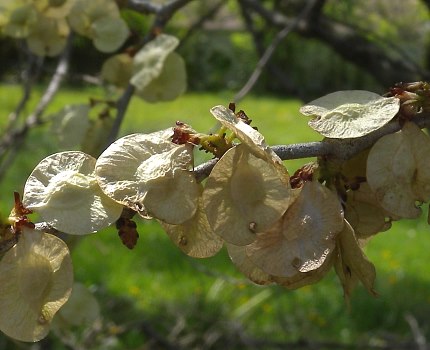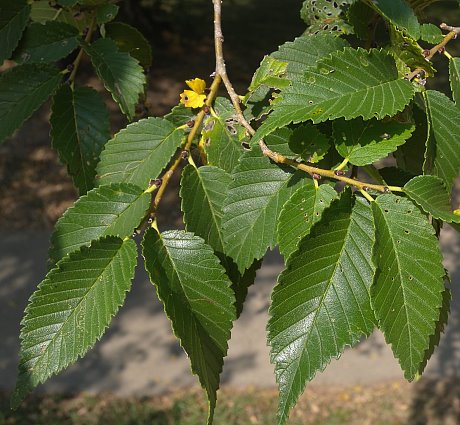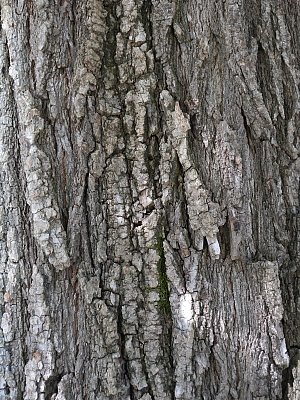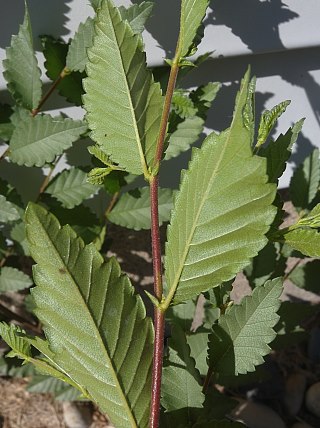
Small clusters of 3-15 perfect flowers are produced at intervals along branches of the preceding year. Individual flowers are about 1/8" (3 mm.) across, consisting of a green calyx with 4-5 lobes, 4-8 exerted stamens, and a flattened pistil with a divided style. There are no petals. The slender pedicels are about 1/8" (3 mm.) in length. The blooming period occurs from early to mid-spring before the leaves develop, lasting about 1 week. The flowers are cross-pollinated by the wind; they are also self-fertile. The flowers are replaced by glabrous samaras that are light green, oval-orbicular to orbicular in shape, and flattened; they become about ½" long and light tan at maturity. Each samara has a single seed at its center, which is surrounded by a broad membranous wing. The samaras are distributed by the wind during late spring or very early summer. Under damp conditions, the seeds have the capacity to germinate within a week or two. The woody root system is branching and widely spreading. The deciduous leaves turn yellow for a short period during the autumn before falling to the ground.

Cultivation: This tree adapts to full sun, moist to dry conditions, and practically any kind of soil, except highly acidic. Because of reduced competition from other trees, it tends to thrive in barren soil containing too much sand, gravel, or clay. Growth and development of young trees is rapid, and their longevity can extend to 50-100 years. Siberian Elm is resistant to Dutch Elm disease, which is often fatal to other elms. It is prone to storm damage from wind, snow, and ice (especially the latter), causing breakage of branches and twigs that can litter the ground underneath the tree. The frequent result of such damage is a tree with an ungainly and ragged appearance. Another problem is the tendency of its roots, like Willow trees (Salix spp.), to seek out water, clogging underground water and sewer lines. In relatively open areas, this tree can reseed itself aggressively and become a nuisance in areas that are beyond the reach of a lawnmower. On the positive side, its open crown allows enough light to pass through and maintain turfgrass underneath.
 Range & Habitat: The non-native Siberian Elm has naturalized in many areas of Illinois (see Distribution Map). Its abundance is highly variable across different localities within the state, although it tends to naturalize more often in urban and suburban areas. This tree was introduced into the United States from east-central Asia. During the 1950s, it was widely planted as a replacement for the native American Elm (Ulmus americana) in lawns and along streets. This was in response to the sharp decline in populations of American Elm after the introduction and spread of Dutch Elm Disease in the United States. In Illinois, habitats of Siberian Elm include open disturbed woodlands, thickets and weedy meadows, areas along buildings, roadsides and areas along railroads, vacant lots, and fence rows. Because of Siberian Elm's intolerance of shade, relatively open habitats with a history of disturbance are preferred.
Range & Habitat: The non-native Siberian Elm has naturalized in many areas of Illinois (see Distribution Map). Its abundance is highly variable across different localities within the state, although it tends to naturalize more often in urban and suburban areas. This tree was introduced into the United States from east-central Asia. During the 1950s, it was widely planted as a replacement for the native American Elm (Ulmus americana) in lawns and along streets. This was in response to the sharp decline in populations of American Elm after the introduction and spread of Dutch Elm Disease in the United States. In Illinois, habitats of Siberian Elm include open disturbed woodlands, thickets and weedy meadows, areas along buildings, roadsides and areas along railroads, vacant lots, and fence rows. Because of Siberian Elm's intolerance of shade, relatively open habitats with a history of disturbance are preferred.Faunal Associations: A variety of insects feed on Siberian Elm (Ulmus pumila) and other elms (Ulmus spp.), and this includes such species as the larvae of wood-boring beetles, larvae of bark beeltes, leaf beetles, weevils, plant bugs, stink bugs, aphids, leafhoppers, treehoppers, mealybugs, armored scales, walkingsticks, larvae of various sawflies, larvae of various moths, and larvae of brush-footed butterflies (see Insect Table). Some of these insects, however, may not feed on Siberian Elm because it isn't native to North America. One insect that isn't listed, the Common Dog Day Cicada (Tibicen linnei), definitely feeds on the roots of Siberian Elm (personal observation). Among vertebrate species, many species of birds feed on the buds, florets, and/or samaras (seeds) of these trees. These species include the Wood Duck, Northern Cardinal, Rose-breasted Grosbeak, Evening Grosbeak, Clay-colored Sparrow, House Sparrow, Common Redpoll, Purple Finch, Pine Siskin, American Goldfinch, Black-capped Chickadee, Carolina Chickadee, Yellow-rumped Warbler, Bobwhite Quail, Ruffed Grouse, Wild Turkey, Ring-necked Pheasant, and Greater Prairie Chicken. In addition, the Yellow-bellied Sapsucker sucks the sap of these trees by drilling holes through the bark (DeGraaf, 2002; Martin et al., 1951/1961; DeVore et al., 2004; Schwartz, 1945). Mammals that feed on elms include the American Beaver (wood, bark), White-tailed Deer (twigs), Cottontail Rabbit (bark of saplings), Eastern Gray Squirrel (seeds), and Fox Squirrel (buds, florets, and seeds); see Martin et al. (1951/1961). Because Siberian Elm frequently has branches that break off the tree duing stormy weather, this promotes the development of cavities that are used as nesting habitat by such birds as the House Sparrow, European Starling, Black-capped Chickadee, White-breasted Nuthatch, and Downy Woodpecker. Tree squirrels also use such cavities as dens.

Photographic Location: Residential areas near the webmaster's apartment complex in Urbana, Illinois.
Comments: This tree probably has more potential to be invasive in the Great Plains and western states, than Illinois, where the fertile soil and abundant moisture of the latter enables oaks, maples, and other tall canopy trees to flourish. Under these circumstances, Siberian Elm is unable to compete with the taller and more shade tolerant tree species, except as a pioneer tree in disturbed areas. Siberian Elm is easily distinguished from other native elms (Ulmus spp.) by its small leaves (often only 1" in length). Sometimes, it is referred to as 'Chinese Elm,' but this corresponds to another species, Ulmus parvifolia, that differs by having flaky trunk bark, rather than furrowed bark, and flowers that bloom during late summer or autumn.